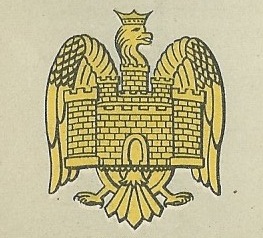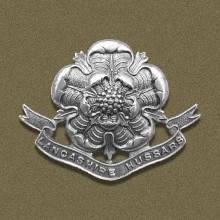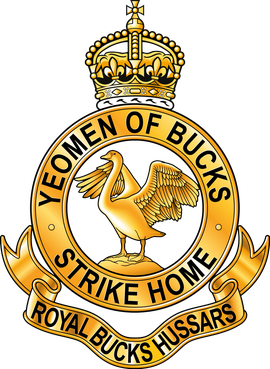Options for Change was a restructuring of the British Armed Forces in summer 1990 after the end of the Cold War.
106 (Yeomanry) Regiment Royal Artillery is part of the Army Reserve and has sub-units throughout the South of England. The Regiment's role is Close Air Defence and it was part of the Joint Ground Based Air Defence formation, later 7 Air Defence Group and uses the Starstreak missile. Two Batteries will be armoured and will operate in support of maneuver forces whilst one Battery will be equipped with the lightweight LML version. The Regiment is paired with 12 Regiment Royal Artillery for training, exercise and operations.
Precedence is the order in which the various corps of the British Army parade, from right to left, with the unit at the extreme right being highest.

The 1st Cavalry Division was a regular Division of the British Army during the First World War where it fought on the Western Front. During the Second World War it was a first line formation, formed from Yeomanry Regiments. It fought in the Middle East before being converted to the 10th Armoured Division.
The 1957 White Paper on Defence was a British white paper issued in March 1957 setting forth the perceived future of the British military. It had profound effects on all aspects of the defence industry but probably the most affected was the British aircraft industry. Duncan Sandys, the recently appointed Minister of Defence, produced the paper. The decisions were influenced by two major factors: the finances of the country and the coming of the missile age.

The 49th Infantry Brigade, later known as 49th (Eastern) Infantry Brigade during the Cold War, was a brigade of the British Army.

The Bedfordshire Yeomanry was a Yeomanry regiment of the British Army. Serving intermittently between 1797 and 1827, it was re-raised in 1901 for the Second Boer War. It participated in the First World War before being converted to an artillery regiment. It served in the Second World War. Its lineage was maintained by 201 Battery, 100th (Yeomanry) Regiment Royal Artillery until that unit was placed in suspended animation in 2014.

103rd Regiment Royal Artillery is part of the Army Reserve and primarily has sub-units throughout the Greater Manchester and Merseyside area of the North-West of England, in recent years it has extended its footprint to Wolverhampton, Isle of Man, Carlisle and Nottingham. Its purpose is to provide reinforcements for units that use the 105 mm L118 Light Gun.

The Lancashire Hussars was a British Army unit originally formed in 1798. It saw action in the Second Boer War, the First World War and the Second World War. In 1969, the regiment reduced to a cadre and the Yeomanry lineage discontinued.

The South Nottinghamshire Hussars is a unit of the British Army formed as volunteer cavalry in 1794. Converted to artillery in 1922, it presently forms part of 103 Regiment, Royal Artillery.

The Duke of York's Own Loyal Suffolk Hussars was a Yeomanry regiment of the British Army. Originally formed as a volunteer cavalry force in 1793, it fought in the Second Boer war as part of the Imperial Yeomanry. In the World War I the regiment fought at Gallipoli, in Palestine and on the Western Front. The unit was subsequently converted into a Royal Artillery unit, serving in the anti-tank role North Africa, Italy and France during World War II. The lineage is maintained by No. 677 Squadron AAC.
The Denbighshire Hussars was a Welsh Yeomanry regiment of the British Army formed in 1794. It saw service in the First World War before being converted into a unit of the Royal Artillery. The lineage has been continued by 398 Squadron, Royal Logistic Corps.

The Royal Buckinghamshire Yeomanry is an Operational Hygiene Squadron of the Royal Logistic Corps, originally formed as cavalry in 1794, and has also served in artillery and signals roles. The lineage is continued by 710 Operational Hygiene Squadron, Royal Logistic Corps.

The Hertfordshire Yeomanry was a Yeomanry Cavalry regiment of the British Army that could trace its formation to the late 18th century. First seeing mounted service in the Second Boer War and World War I, it subsequently converted to artillery. Three regiments saw service in World War II, one of which was captured at the fall of Singapore. It continued through various postwar amalgamations and its lineage was maintained by 201 Battery, 100th (Yeomanry) Regiment Royal Artillery until that unit was placed in suspended animation in 2014.
During the First World War the British Armed Forces was enlarged to many times its peacetime strength. This was done mainly by adding new battalions to existing regiments. Although sometimes identified by shoulder titles, generally the new battalions could not be identified from appearance. Consequently, the units in this list have been assembled considering only those as having a uniquely different cap badge.

The 86th Field Regiment, Royal Artillery, was a unit of Britain's part-time Territorial Army (TA) formed after World War I from existing artillery and Yeomanry Cavalry units recruited in Hertfordshire. Its self-propelled guns were among the first artillery to land in Normandy on D Day and served throughout the North West Europe campaign in World War II, seeing action in Normandy, at the liberation of Antwerp, in Operations Market Garden, Clipper and Veritable, the Rhine crossing and the advance across Germany. The regiment continued in the postwar TA until 1967, and its successor battery continued to 2014.
The 289 Commando Troop originated as a parachute artillery regiment of the Territorial Army formed in London in 1956. It was transferred to the Royal Horse Artillery in 1960 and reduced to a battery in 1967. In 1977 it was re-roled as a Commando battery before being reduced to a troop in 1999. It is now based in Plymouth as a detached part of 266 Battery where they perform the same Close Support Light Gun Role as part of 104 Regiment Royal Artillery, whilst also supporting 29 Commando Regiment in an unofficial role.
The IV East Anglian Brigade of the Royal Field Artillery was a unit of Britain's Territorial Force (TF) from 1908 to 1919. It served in the Sinai and Palestine Campaign during World War I.









